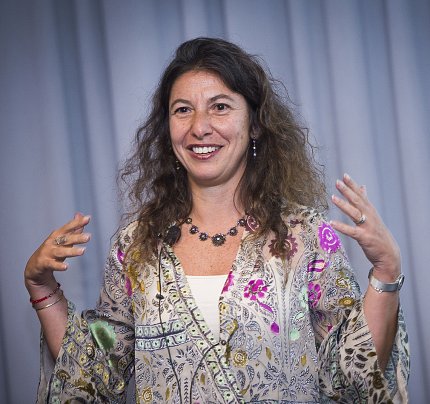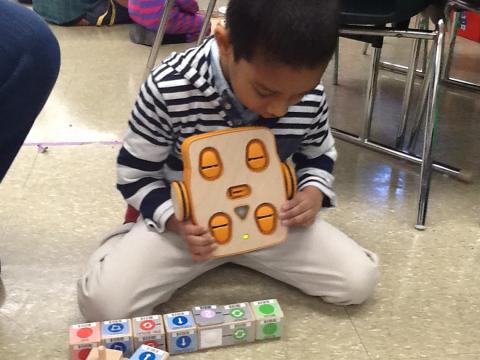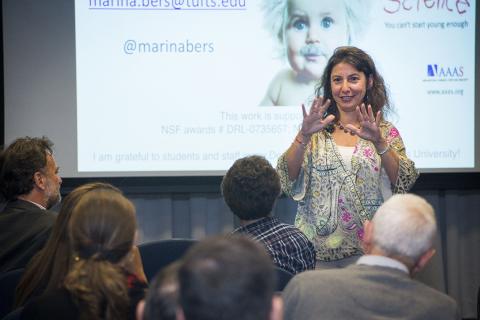Tech for Tots
Lab Develops Coding Toys for Young Kids

Photo: Lisa Helfert
These days, many kids know the alphabet and are starting to read by the time they get to kindergarten. Becoming literate in today’s world, however, may also require learning another kind of language—that of computer programming.
Coding is all around us. It’s found in things we touch and use every day, from smartphones to embedded sensors in ordinary objects. But can little kids learn coding?
“We want kids to understand that the world around them is full of smart objects and these objects have been programmed and it’s as simple as that,” said Dr. Marina Umaschi Bers, professor at Tufts University and co-founder and chief scientist of KinderLab Robotics. She spoke at a recent NIMH Director’s Innovation Speaker Series lecture at the Neuroscience Center.
Bers has spent decades researching ways to embed computer science into early childhood education. Some 20 years ago, as an MIT Media Lab graduate student, she was mentored by Seymour Papert, a pioneer in developing the first programming languages and robotic kits for children.
“We believe that coding is the literacy of the 21st century,” said Bers. “Literacy allows us to communicate, to generate and interpret meaning but, most importantly, it changes the way we think.”
Coding is a symbol system that uses a programming language. Though it relies heavily on math and science, coding also promotes problem-solving, trial and error, logic, ingenuity and abstract and strategic thinking, skills important for everyone. And although coding involves some complicated concepts, from algorithms to control structures, even children can learn coding through developmentally appropriate environments and toys.
Bers and her DevTech research group at Tufts created two such coding experiences for youngsters. The first, Scratch Jr., is an interactive app, free to download, designed for kids ages 5 to 7. They choose or create characters and scenes, then drag and drop blocks to program the character to complete a series of actions. A kid might make a frog, for example, which jumps, then shrinks, then jumps again and ribbits. Suddenly, the child is playing a fun game that he or she programmed.

Photo: DEVTECH/Tufts
Scratch Jr. is based on Scratch, developed by MIT Media Lab for older kids. Unable to use Scratch with her own children because they were too little, Bers became inspired to collaborate with MIT on an age-appropriate junior version. Since launching in 2014, Scratch Jr. has had millions of downloads and has more than 200,000 weekly users.
But something was missing, recounted Bers. While Scratch Jr. fosters creative, open-ended play, it lacked a body. Bers wanted to develop a coding experience that simulates the playground experience, one that’s active, social and didn’t require eyes on a screen.
“Technologies are leaving laptops; they’re becoming more part of the objects around us,” said Bers, “so we need to understand the different impacts of the different interfaces and designs.”
With that in mind, her DevTech lab invented KIBO, a small robot programmed with wooden blocks. KIBO has sensors to detect light, sound and distance and a light bulb that reflects output. The robot’s scanner then reads the bar codes in the blocks.
“We start teaching kids from 4 years old the difference between an input and an output, while teaching them complex ideas from computer science,” she said.
The child connects the programming blocks, then glides the robot over the blocks to scan their icons and tags. This brings the robot to life as it sings, dances, spins, beeps and lights up based on the sequence the child created.
“But the robot isn’t finished because what’s missing is the kid’s individuality,” said Bers. Kids are encouraged to decorate their robots. “We built art platforms for kids to bring their creativity and integrate their recyclables or other kinds of materials into the robot.”
KIBO has more than 20 curriculum units to guide teachers who use it in classrooms. One unit is Dances Around the World, where kids can celebrate and learn about different cultures. Users can program their KIBO to dance to whatever they choose to choreograph, from the hula to the tango to Hava Nagila.
“That’s what we’re really looking for when we’re teaching robotics and coding,” said Bers. “We want to see the child or the adult behind it...who can use it to express themselves and really show who they are.”
Although target groups for developing KIBO were kids with no known disability, Bers said they piloted KIBO with autistic children. At a school in Panama, the autistic youngsters understood how to program KIBO; interestingly, though, they all reversed the sequence by starting with an End block. The teacher had to flip the blocks around to make them scannable.

Photo: Lisa Helfert
Recently, Bers has begun collaborating on research to learn what parts of the brain become activated when kids program. The problem-solving areas of the brain are likely to light up on fMRI but what about other areas? If coding is a literacy, would language areas also become activated when kids program?
“If you start in early childhood, at a time when everyone is curious and open, and you take the mindset of a literacy approach, then we’re really talking about something [much bigger],” said Bers. “Literacy is a power and gives us a voice. We know that those who can use [coding] language are those who are going to be in control of the future.”
